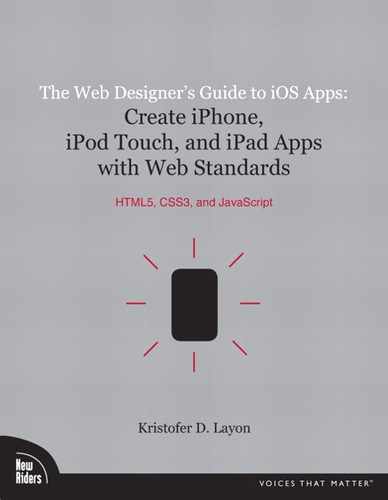11. Marketing Your Apps
I always tell people that I view design as a holistic activity: The visioning, planning, and creative work involves more than making the thing that you’re designing. Much of the creative challenge lies in nurturing the human relationships involved in design projects, as well as managing the various outcomes that can occur after the “creative work” is done.
In other words, it’s all design—and all of the work for a project, from beginning to end, is creative because it is all interconnected.
So as you travel the arc of iOS app planning, design, and management, you’ll need to consider some of the more communications- and marketing-oriented decisions. Because creating an app is a lot of the work, but it’s not all of the work. Who is the audience for your iOS app, who is the client, and how do you want to shape your relationship with these entities, and with Apple? And what are Apple’s guidelines for doing this?
This chapter is less technical, but don’t think that makes it any less important. Read on so you can be just as savvy with the communications and marketing aspects of your app as with the other creative aspects of iOS app design.
Who are you: Deciding on an App Store identity
This isn’t just a rhetorical question. Seriously, who do you want to be when designing apps and making them available to customers? Here are some options to consider.
You are you
Perhaps you want to keep things straightforward and, if you already registered as an Apple Developer under your own name, do any app design consulting or collaboration with others under your own name. Similarly, you may want to submit apps to Apple as an individual as well.
Designing and submitting apps as an individual has the following advantages:
• You can distribute or sell your apps via the App Store.
• It is immediately obvious who has designed your apps because they’re listed under your name in the App Store.
• There may not be any financial or legal hoops to jump through in your state to do business as an individual.
• It is likely to be faster and easier to do business as a sole proprietor, and submit apps to Apple as an individual.
On the other hand, designing and submitting apps as an individual may have the following disadvantages:
• You are probably personally liable for all business and design decisions that you make, in any event that an app client or customer has a problem with your work.
• You give up some anonymity and privacy by submitting and distributing iOS as an individual. After all, your name will be listed in the App Store!
• The annual cost of being in the regular Developer Program is currently $99. If you’re registered as an individual developer, you’re on the hook for covering the annual fee all by yourself (unless you recover the cost with consulting fees).
Take these considerations into account if you’re thinking about operating as an individual or sole proprietor, and become familiar with local, state, and federal commercial and tax requirements that may pertain to your form of business.
You are your company
Perhaps you’re like me and want to distribute your apps via a company name. When I formed my company (Aesthete Software, LLC), I did it for these advantages, so see if they fit what you are looking for:
• You want to look more established and professional by being listed in the App Store under a company name.
• You would like to limit your personal and family liability by creating a form of business, such as a limited liability corporation (LLC).
• You have identified tax advantages of doing work as a company rather than as an individual.
Of course, as with any option there are downsides to this one, too:
• It takes some time and, often, some expense to create a new legal entity for a company.
• There may be additional tax forms to complete—as if taxes were not enough work already!
• If you want to take this route to its logical conclusion, you could end up paying for additional company costs such as a new web domain, web hosting, and so on. (This could be in addition to any personal website expenses you already have.)
Even though I took this route for my app distribution, don’t follow my lead without thinking through your entire business plan, budget, and willingness to try new things. Designing apps may be enough new work for you—creating and managing a new business entity may not be on your priority list at the moment, and that is just fine.
You are your employer or organization
Another option for designing and distributing iOS apps is to participate in Apple’s Enterprise Program. The annual fee for this program is currently $299.
Designing and submitting apps as an enterprise has the following advantages:
• You should be able to get your company to cover the annual fee.
• You likely have in-house financial and legal resources available to you for consultation and assistance as you navigate the iTunes Connect business processes.
• If you are designing apps only for in-house use, the Enterprise Program allows you to distribute apps directly to employees in your company rather than going through the public App Store review and approval process.
On the other hand, designing and submitting apps as an enterprise may have the following disadvantages:
• You cannot sell or distribute your company’s apps through the App Store.
• Your may get less personal recognition for your apps.
• Your company’s apps may get less exposure (though if this route is taken for an internal app, additional exposure may not be relevant).
You are your client
Yet another option for designing and distributing iOS apps is to place them in the App Store not as yourself, your company, or your employer, but as your client.
Designing and submitting apps as your client has the following advantages:
• Your client gets to take on more of the copyright, liability, and financial issues of distributing apps via the App Store.
• This arrangement allows you to more comfortably collaborate on or design an app that doesn’t fit into your overall market focus or app type specialization.
• It allows you to be a bit more risky with designing an app that might not sell or get reviewed well (though to be fair, your association with a bad app can probably come back to haunt you even if it’s listed under your client instead of you personally).
On the other hand, designing and submitting apps as your client may have the following disadvantages:
• Depending on who administers the iTunes Connect account, you may not have financial control in this arrangement and will instead be paid by your client after Apple pays them.
• If the app ascends to a Top Ten list, you may regret not getting all the glory.
If you’re like me, sometimes being confronted with too many choices can be unpleasantly bewildering, especially if you anticipated a more simple process. As in, “I just went to the store to buy toothpaste—I didn’t expect to stand in the aisle, paralyzed by all the options!” This section is not meant to paralyze you, but I encourage you to weigh these options early in your planning process. My hope is that if you consider the options carefully and seek advice early and as needed, then you won’t be found standing in the aisle with a finished app, wondering how to quickly choose an option that may be more than a five-minute decision.
Using Apple’s marketing assets
Apple and its App Store have plenty of critics and, as I noted in the introduction to this book, my decision to write this does not mean that I dismiss all of those criticisms. The iOS app design and distribution processes have plenty of shortcomings, and there are plenty of reasons to perhaps be cynical as to why Apple has designed these opportunities and processes in the ways that it has.
Nonetheless, the numbers generated by the App Store are certainly some of the reasons to take interest in Apple’s mobile platform and app distribution model. There are over 250,000 apps in the App Store, and by January 2010 more than 3 billion apps had been downloaded worldwide.
And that was before the iPad was introduced.
So how can you take advantage of this enormous opportunity and sales momentum for your app? One way is to take advantage of the marketing assets provided by Apple. But take care when you do—Apple’s famous attention to detail and penchant for control means there are some rules about using them.
Using the Available on the App Store badge
The Available on the App Store badge has surely has become one of the most recognizable graphic icons in the world in just a few short years (Figure 11.1).
11.1 The Available on the App Store badge.

I have to admit, there was a brief yet huge moment of excitement when I added it to the website I had created for my first app—I had arrived!
Needless to say, you’ll want to use this graphic on any communications about your app, whether you’re distributing or selling, and whether you’re doing it for yourself, your employer, or your client. The graphic is instantly recognizable and has become a potent symbol in the heated competition between mobile operating systems (and native versus web apps).
Note that when you use this graphic, you are subject to the guidelines, requirements, and limitations as defined in Apple’s App Marketing Artwork License Agreement. Here are some of the more important guidelines for using the Available on the App Store badge:
• Do not modify the graphic in any way. This includes changing its color, rotating it, adding or subtracting any elements of the graphic, or rearranging any of the elements.
• Follow the clear space requirements for implementation: 10 millimeters around the graphic in print, and 40 pixels on the web.
• Create a clear hierarchy where the badge is secondary to your other app branding and identity elements.
• You are not limited to a white or black background as you might expect from Apple, but they do expect you to make a judgment call about the badge remaining legible and being clear of visual clutter or patterned backgrounds.
• You must link to your application on the App Store whenever the badge is used. To get your app’s URL, find it in iTunes and select Copy Link in the small dropdown menu located under the app icon (Figure 11.2). Use this URL either as a link from your own website or as copy in other promotional materials.
11.2 How to copy an app’s URL in the App Store.
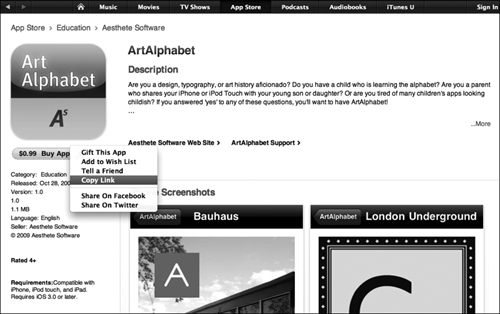
For additional details, refer to Apple’s App Marketing and Identity Guidelines for Developers, available as a PDF in the iOS Dev Center.
Using official iOS device images
Once you agree to the App Marketing Artwork License Agreement and download the graphics provided by Apple, you are eligible to use the official iOS device images that are downloadable from the iOS Dev Center website.
As you have probably guessed, Apple has a handful of guidelines regarding your use of these images, too:
• Use only Apple-provided device images in your app’s promotional materials. Do not take your own photos of your app running on a device, although taking your own screenshots is allowed and, in fact, necessary for showing your app. Instead, layer such screenshots on top of the device image provided by Apple.
• Do not use Apple iOS device images alongside an image of another mobile device. (This rule makes me laugh a bit!)
• Unlike the App Store badge, there is a strict background requirement for the device images: white is the only acceptable background.
• Do not place any promotional copy or images in the screen area of an iOS device image. The only acceptable images for the screen area are screenshots of your app as it runs on a device or in the Simulator.
• As with the App Store badge, do not modify device images in any way other than adding an app screen shot to the device’s screen area. Prohibited modifications include changing color, rotating, adding or subtracting any elements of the graphic (including the iOS status bar), or rearranging any of the elements.
If you have any questions, please refer to Apple’s App Marketing and Identity Guidelines for Developers for additional details.
Using Apple-approved language
Even when it comes to written descriptions of your app, Apple has a few opinions as to how you should proceed. For example, if your app is called AweSome MegaApp, you can refer to it as AweSome MegaApp for iPhone but not iPhone AweSome MegaApp in your communications about it.
Apple is also quite discerning about how you use the term App Store. Despite it being in iTunes, you are not allowed to add descriptors such as iTunes App Store or iPhone App Store. It’s just App Store, and you are recommended to say things like your app being “available in the App Store” or able to be “downloaded from the App Store.” And interestingly, Apple does not allow App Store to be translated into another language, even when used in communications in another language.
It is the App Store, and it shall remain the App Store.
Also, do not refer to Apple product names in your communications except for describing app compatibility either generally or specifically. And note that iPod touch is required to have a lower-case t in touch.
Did I mention that Apple was detail-oriented?
Some of Apple’s language requirements are a bit tedious to describe, but I hope this is a good introduction to their top requirements. You are encouraged, however, to keep up with the details and any updated recommendations by checking in with the marketing resources on Apple’s iOS Dev Center.
Using Apple-approved typography
Finally, don’t think that Apple has no opinion on the typeface you use in your app communications—it does.
Fortunately, the rule is quite simple: You are forbidden to use any version of the Myriad typeface, because Apple uses a version of it in their corporate communications and they do not want your communications to be confused with theirs. Fair enough, though too bad for us (as Myriad is a nice typeface).
Designing your own app marketing communications
The fact that the App Store has over 250,000 apps means that it has a ton of traffic, and is currently the main point of contact for the majority of people in the world who are shopping for native mobile apps. No other mobile device has an app store with as many products or customers. This is great news for iOS app designers.
But having over 250,000 apps also means that your app is the proverbial needle in the haystack. Depending on what it does, your app could have a lot of competition. And depending on how it is categorized and positioned in the App Store, it could have either thousands of downloads or just a handful. This is the downside of the App Store for iOS app designers.
Naturally, success is defined by the scope and goals of any given app. A very specialized app might be designed to appeal to only a very narrow audience; most of the ones I have designed fall into this category. Nonetheless, I still want my target audience to find it. Using the web is a valuable tool in helping to get the word out.
So whether you are seeking exposure to all iOS device owners for a general purpose app or one that could have very broad appeal, or targeting a specific profession or audience with a niche application, consider your online communication options during your design process.
Designing an app website
Apple requires a URL for any app that is submitted to the App Store for approval. This URL could be a blog, a personal website, your employer’s website, or your own company website—but it needs to go to a real website.
And let’s face it, any additional publicity for your app is good publicity. An app website (or page) helps your app feel “more real,” it may be able to inform people more quickly about what it does, and it gives you a much wider range of options than relying on the App Store alone.
I won’t pretend to be an app marketing guru, although I did work for several years in marketing (but that was a while ago and not in this industry). Still, I am happy to share some recommendations based mostly on my own experience with my company’s website, www.aesthetesoftware.com (Figure 11.3).
11.3 The Aesthete Software, LLC, website.
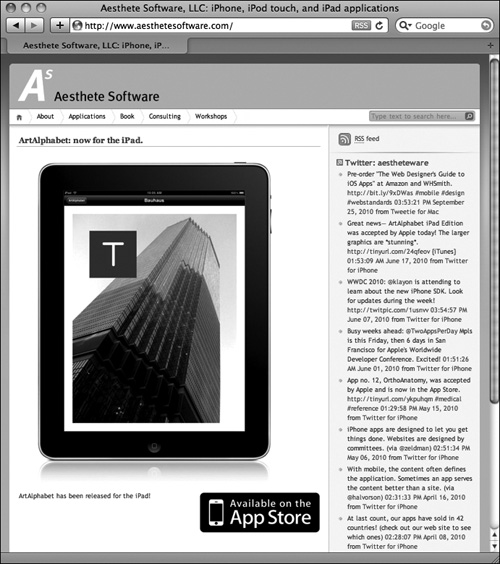
Here are some decisions I made concerning this website and how it relates to marketing the apps I have designed:
• The branding of Aesthete Software, LLC, has been very consistent. The details of the wordmark (typeface, color, spatial relationships) have been consistent between the website and the app graphics in the App Store, as well as in the apps themselves.
• I do my best to maintain an attention-getting home page, usually either with fresh news or with a large image and quick message.
• The navigation for this site has been kept quite simple. I have sections for apps, consulting, workshops, and now this book.
• To keep updating simple and easy to access, I decided to use a web-based content management system. This allows me to add or revise content wherever I am as long as I have an internet connection.
• I incorporated a Twitter feed in my site’s design, so that even if the site’s home page has not been updated recently (which I can be guilty of when busy with other things), there is still current content streamed to the right column of the page (assuming I’ve kept up on Twitter).
In short, I encourage you to be somewhat Apple-like in your approach to communicating about any apps that you design. Use consistency to your advantage: You have not only created an app, you have created a new brand. Read up a bit on branding so you understand what it means to “manage a brand” because, after all, you or someone you are working with will need to skillfully and consistently stay on message with what your app does and for whom.
And if you are creating a suite of apps, be sure to plan how you will tie them together visually and textually. The relationships between you or your company, your app names, and your app graphics will either reinforce or detract from a sense of cohesion in your communications.
Creating an app social media channel
These days, the App Store and a website are just two parts of the puzzle. Social networks are carrying a large amount of today’s web communications—and I’m sure you don’t need me telling you this. You’ve probably logged into Facebook or Twitter today already or may even be logged in at this very moment, as you’re reading this with another part of your over-active brain. So PAY ATTENTION: I have a few words to say about social networking on behalf of your app.
The most important thing to remember about creating a Facebook page, Twitter account, or other social media channel for your app(s) is that creating it is the easy part. Consider the Twitter account for my apps (Figure 11.4).
11.4 The Twitter account for Aesthete Software, LLC.
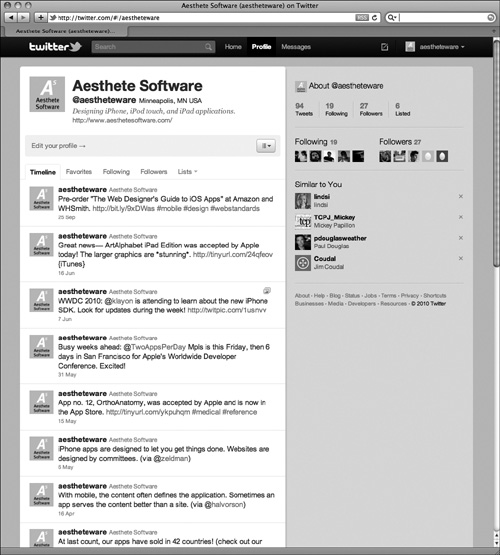
I’ll be the first to admit that my best advice for social media is “do what I say, not what I do.” Although I have been very active on this channel at times, I have also allowed it to languish at other times.
That’s because unlike creating a social media channel, maintaining one and doing it well is extremely difficult.
The difficulty is not particularly technical, but rather it involves discipline. If content feels old on a website in a matter of days or weeks, content can feel old in a social media channel in a matter of hours.
And what will your app updates be about? New content? Version updates? Good. What kind of muffin you are having with your tall skinny cappuccino? Maybe not. Remember that if you open up a new social channel for your app, your content better stay app-focused for the most part. Too much filler will look like you didn’t need the social channel in the first place.
Furthermore, I have learned that very few of my apps’ users are even active on social networks, at least when it comes to their work. So try to get a sense in advance about your audience’s use of social media before embarking on this route for your app (and that, of course, could be tricky and take some time).
There are so many recommendations out there for how to adopt social media to your advantage, I don’t want to rehash it all here. But I would encourage you to consider social media for your app or apps, yet caution you not to think of it as a silver bullet to success. Adopting social media is like marathon training or wine making: It inherently takes time and cannot be rushed, because you need time to build an audience, a social persona, and a pattern of communications that your audience can learn to expect and rely on.
So by all means consider it, but consider it with care.
Communicating via app updates
You may not have thought much about them, but the update messages that you get in the App Store app from designers are also a form of app marketing communications. But the content and format can really vary, and sometimes you are just as likely to skip these messages. What makes them work well, and what makes them work not so well?
For better or worse, these update messages are the most direct way you have of communicating with your app’s customers after they’ve made their free download or purchase. Figure 11.5 (on the next page) shows one example of an update message.
11.5 An update message for Lose It! in the App Store, as viewed on an iPhone.
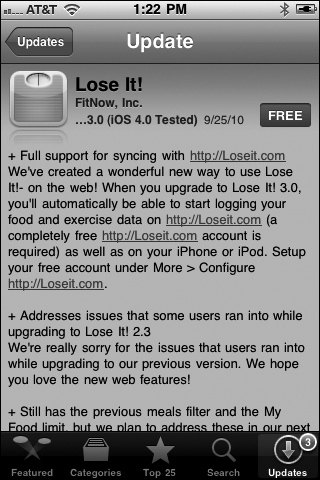
Here are some of the strengths of this message:
• It has a friendly, conversational tone, like the update is speaking with you.
• It is detailed and thorough.
• There are URLs included that link to pages on the app’s website.
And here are some of the weaknesses of this message:
• It is really long.
• The bullet points are quite verbose.
As a comparison, Figure 11.6 shows another app update message for Pandora.
11.6 An update message for Pandora in the App Store, as viewed on an iPhone.
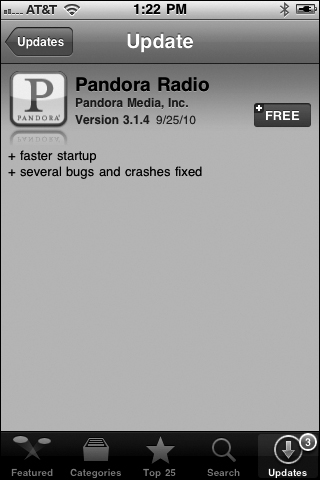
The strengths of this example are clear: The bullet points are short and sweet, and not too numerous, so they are sure to be read. On the other hand, less than 30 percent of the viewable screen is used (not to mention that the update screens scroll, so they can continue below “the fold”). Was this a missed opportunity to do a bit more relationship building with Pandora’s customers?
Here are my recommendations for using app updates messages:
• Learn from these examples and aim for the middle of these two extremes. Be friendly and detailed, but also be concise. Keep individual points short, too.
• Always use a character as a bullet for bullet points, and always put a space in between them. If you don’t do these things, your points are lost when they run together into one giant, gelatinous block of text that people will ignore.
• Try to keep your update message within the confines of the iPhone screen. This is about 18 lines of text (at approximately 50 characters per line). And don’t be tempted to make your update messages much longer for an iPad app just because the screen is larger.
• Use updates as an excuse to remind customers to email you with feedback or suggestions, or rate your app in the App Store.
That is, make it more like the example shown in Figure 11.7.
11.7 An update message for TripIt in the App Store, as viewed on an iPhone.

Be creative with this rare opportunity to communicate with your customers and market new or updated features to them. If you can be concise, informative, and friendly, your app updates will enhance your and your app’s reputation and help your customers remember to refer your work to others.
Summary
In this chapter you learned how to
• Consider what kind of presence you want in the App Store: yourself, your company, your employer or organization, or your client.
• Use the Available on the App Store badge and device images provided by Apple (and use them properly).
• Follow Apple’s text guidelines for marketing messages, and how to not typeset your text in Myriad.
• Create your own app website and social media channels that communicate clearly to your customers, and augment the online presence of your app beyond the App Store itself.
• Write app update messages that are clear, concise, readable, and helpful—and strengthen your relationship with your customers.
You’ve now traveled nearly the entire iOS app design journey: from getting the app design tools you need, to learning about the iOS interface and user experience, to trying out techniques for designing various kinds of app content. This, coupled with marketing guidelines and tips, means that you’re ready for the finish line: distributing your app via the iTunes App Store.
